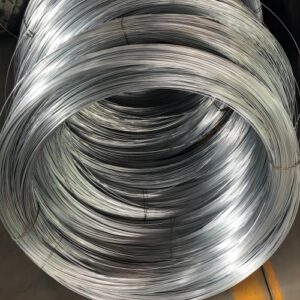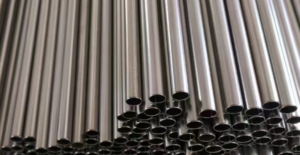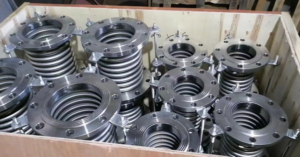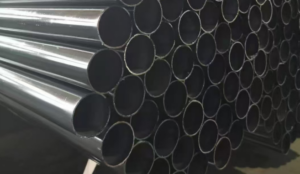Inconel 600
Inconel 600 alloy is a nickel-chromium-iron based solid solution strengthened alloy with good resistance to high temperature corrosion and oxidation, excellent cold and hot processing and welding properties, and satisfactory thermal strength and high plasticity below 700℃.
Production standards for inconel 600

| Standard Organization | Standard Number | Description |
|---|---|---|
| ASTM International | ASTM B166 | Standard specification for nickel-chromium-iron alloys (UNS N06600, N06601, N06603, N06690, N06693, N06025, and N06045) rod, bar, and wire. |
| ASTM International | ASTM B168 | Standard specification for nickel-chromium-iron alloys (UNS N06600, N06601) plate, sheet, and strip. |
| ASTM International | ASTM B167 | Standard specification for nickel-chromium-iron alloys (UNS N06600, N06601, N06690, N06693, N06025, and N06045) and nickel-chromium-cobalt-molybdenum alloy (UNS N06617) seamless pipe and tube. |
| SAE International | AMS 5540 | Specification for nickel alloy, corrosion and heat-resistant, sheet, strip, and plate. |
| SAE International | AMS 5665 | Specification for nickel alloy, corrosion and heat-resistant, bars, forgings, and rings. |
Content
Applications of inconel 600
Inconel 600 is renowned for its excellent resistance to heat and corrosion, making it suitable for a wide range of applications, especially where high temperatures and corrosive conditions are prevalent. Here are some specific applications that capitalize on the unique properties of Inconel 600:
Chemical Processing: Inconel 600’s resistance to oxidation and corrosion makes it ideal for use in reactors, heat exchangers, and other components in chemical processing plants, especially those handling caustic or acidic substances.
Aerospace: The alloy’s resistance to high-temperature environments makes it suitable for aerospace applications, including exhaust liners, turbine seals, and airframe components that must withstand intense heat and stress during operation.
Power Generation: Inconel 600 is used in superheater and reheater tubes in power plants. Its ability to withstand high temperatures and corrosive environments helps maintain the integrity and efficiency of the power generation process.
Heat Treatment Furnaces: The material’s resistance to carburization and nitriding, common in heat treatment processes, makes it suitable for furnace components, such as muffles, retorts, and conveyor belts.
Nuclear Engineering: Due to its high strength and resistance to radiation damage, Inconel 600 is used in nuclear reactors. It can be found in control rod components and reactor vessels.
Food Processing: Inconel 600’s non-reactive qualities make it suitable for food processing applications, where it’s essential to prevent contamination and withstand cleaning and sterilization processes.
Cryogenic Applications: The alloy retains its mechanical properties at very low temperatures, making it ideal for containing or transporting cryogenic substances like liquid natural gas.
Desalination Plants: The alloy’s resistance to chloride ion stress-corrosion cracking is crucial in desalination plants, where components are regularly exposed to salty, corrosive environments.
Each of these applications leverages Inconel 600’s unique properties, particularly its ability to maintain structural integrity under high temperature and corrosive conditions, demonstrating the material’s versatility across various industries.
Chemical composition of inconel 600(%)
| Element | Composition |
|---|---|
| Nickel (Ni) | ~72% |
| Chromium (Cr) | 14% – 17% |
| Iron (Fe) | 6% – 10% |
| Manganese (Mn) | Up to 1% |
| Copper (Cu) | Up to 0.5% |
| Carbon (C) | Up to 0.15% |
| Silicon (Si) | Up to 0.5% |
| Sulfur (S) | Up to 0.015% |
Physical properties of inconel 600
| Property | Value |
|---|---|
| Density | 8.47 g/cm³ |
| Melting Point | 1370-1425 °C |
| Thermal Conductivity at 100°C | 14.9 W/m-K |
| Specific Heat | 444 J/kg-K |
| Electrical Resistivity at 20°C | 1.03 micro ohm-m |
Mechanical properties of inconel 600
| Property | Value |
|---|---|
| Tensile Strength | 550-690 MPa |
| Yield Strength | 240 MPa |
| Elongation | 30-40% |
FAQs about inconel 600
Inconel 600, due to its nickel-chromium content, exhibits a unique set of properties that make it particularly well-suited for applications requiring high-temperature resistance and stability during heat treating processes. Here’s a detailed look at its capabilities in the context of heat treating, focusing on the scientific aspects:
High-Temperature Stability: Inconel 600 maintains its strength over a wide temperature range. Unlike many other materials, it doesn’t become brittle or lose its mechanical properties when exposed to high temperatures, making it ideal for heat treating applications where uniform heating and cooling rates are crucial.
Resistance to Oxidation and Carburization: At elevated temperatures, Inconel 600 forms a thick, stable, passivating oxide layer that protects the underlying material from further attack. This oxide layer is highly adherent and regenerates rapidly if damaged, providing excellent resistance to oxidation and carburization, which are common in heat-treating environments.
Creep Resistance: Creep is the tendency of a solid material to move slowly or deform permanently under the influence of mechanical stresses. Inconel 600 demonstrates excellent creep resistance at elevated temperatures, which is crucial for maintaining dimensional stability during long-term exposure to high temperatures in heat treating processes.
Corrosion Resistance: Heat treating often involves exposure to harsh environments, including various chemicals and gases. Inconel 600’s resistance to a wide range of corrosive environments, including acidic and alkaline conditions, ensures that components made from this alloy will not degrade, even under aggressive conditions.
Thermal Conductivity: Inconel 600 has a relatively low thermal conductivity compared to other metals, which can be an advantage or a disadvantage depending on the application. In heat treating, this means that the material will heat and cool more slowly, allowing for more controlled temperature gradients and reducing the likelihood of thermal shock.
Weldability: Despite its high strength and durability at high temperatures, Inconel 600 can be welded without preheating, which is beneficial during the fabrication of complex components that require heat treating. The material’s weldability ensures that any joints or repairs will maintain the same high resistance to heat and corrosion as the base material.
In summary, Inconel 600’s high-temperature stability, resistance to oxidation and carburization, excellent creep resistance, and overall durability under harsh conditions make it an exceptional choice for heat treating applications in industries where precision and material integrity are paramount. Its capabilities allow it to withstand the rigorous conditions of heat treating processes while maintaining its mechanical properties and structural integrity.
Inconel 600 and Inconel 625 are both nickel-based superalloys, known for their high strength and excellent corrosion resistance, but they have different compositions and properties, which make them suitable for various applications. Here’s a comparative analysis of Inconel 600 and Inconel 625:
Chemical Composition:
- Inconel 600: Consists mainly of nickel (approx. 72%), chromium (14-17%), and iron (6-10%). It has minimal amounts of carbon, manganese, sulfur, silicon, and copper.
- Inconel 625: Contains a higher concentration of chromium (20-23%) and molybdenum (8-10%) compared to Inconel 600. It also includes a significant amount of nickel (approx. 58%), along with niobium (3.15-4.15%), which acts with the molybdenum to stiffen the alloy’s matrix and provide high strength without a strengthening heat treatment.
Mechanical Properties:
- Inconel 600: Exhibits good strength and is excellent for applications requiring high-temperature resistance. It has good tensile strength and excellent mechanical properties at sub-zero temperatures.
- Inconel 625: Offers higher strength and toughness than Inconel 600, partly due to the addition of niobium, which acts with molybdenum to provide strength. It has excellent fatigue strength and stress-corrosion cracking resistance to chloride ions.
Corrosion Resistance:
- Inconel 600: Provides good resistance to many corrosive environments, including organic and inorganic compounds, alkaline solutions, and chloride-ion stress-corrosion cracking.
- Inconel 625: Exhibits outstanding resistance to pitting, crevice corrosion, and intergranular corrosion. It has excellent resistance to chloride-ion stress-corrosion cracking, reducing environments, and oxidizing environments due to the high chromium and molybdenum content.
Temperature Resistance:
- Inconel 600: Maintains strength over a broad temperature range, making it suitable for applications involving high-temperature processes.
- Inconel 625: Has a higher resistance to elevated temperatures, maintaining its strength even under severe thermal conditions due to the solid solution effects of molybdenum and niobium on its nickel-chromium matrix.
Applications:
- Inconel 600: Used in furnace components, chemical processing, food processing, and nuclear engineering.
- Inconel 625: More suitable for harsh environments, it’s used in aerospace components, chemical processing, marine engineering, and pollution control equipment.
Cost:
- Inconel 625 is generally more expensive than Inconel 600 due to its higher nickel and molybdenum content, which offer enhanced properties but at a higher material cost.
Choosing between Inconel 600 and Inconel 625 depends on the specific requirements of the application, including the expected mechanical stresses, corrosive environments, and temperature conditions the material will face.
The density of Inconel 600 is approximately 8.47 grams per cubic centimeter (g/cm³). This property is crucial for calculating the weight of a component made from Inconel 600, especially in applications where material weight plays a significant role.
Incoloy 800 and Inconel 600 are both high-performance alloys widely used in extreme environments, but they are designed for somewhat different conditions due to their distinct compositions and properties. Here’s a comparative analysis of Incoloy 800 and Inconel 600:
Chemical Composition:
- Incoloy 800: Primarily consists of nickel (30-35%), chromium (19-23%), and iron (39.5% min). It also includes small amounts of aluminum (0.15-0.60%) and titanium (0.15-0.60%), which enhance its high-temperature properties.
- Inconel 600: Mainly composed of nickel (approx. 72%), chromium (14-17%), and iron (6-10%), with minimal amounts of manganese, copper, silicon, carbon, and sulfur.
Mechanical Properties:
- Incoloy 800: Exhibits good tensile strength, excellent resistance to oxidation and carburization at high temperatures, and maintains good mechanical properties in both high-temperature and cryogenic environments.
- Inconel 600: Known for its high strength and good mechanical properties across a wide range of temperatures, including cryogenic levels. It also has excellent fatigue strength and corrosion resistance.
Corrosion Resistance:
- Incoloy 800: Offers excellent resistance to oxidation, carburization, and sulfur-containing atmospheres at high temperatures. It’s particularly effective in environments where temperatures may cause brittleness or other types of degradation in less durable alloys.
- Inconel 600: Provides superior resistance to oxidizing substances, such as chlorine and sulfur compounds. It also has excellent resistance to chloride-ion stress-corrosion cracking, making it suitable for various corrosive environments.
Temperature Resistance:
- Incoloy 800: Especially designed for high-temperature applications, it can withstand temperatures up to 1100°C (2010°F) without becoming brittle or experiencing significant degradation.
- Inconel 600: Maintains its strength and resistance over a broad temperature range, making it suitable for applications that involve extreme heat.
Applications:
- Incoloy 800: Widely used in applications involving high temperatures and corrosive environments, such as heat-treating equipment, chemical and petrochemical processing, and power plants.
- Inconel 600: Utilized in furnace components, chemical processing, food processing, and aerospace applications, particularly where resistance to heat and corrosion is essential.
Cost:
- Incoloy 800 is generally less expensive than Inconel 600 due to its lower nickel content. However, the cost can vary depending on the specific requirements of the application and market conditions.
In summary, the choice between Incoloy 800 and Inconel 600 depends on the specific environmental conditions and mechanical requirements of the application. Incoloy 800 is typically favored for high-temperature applications where resistance to oxidation and carburization is crucial, while Inconel 600 is preferred for applications requiring high strength and corrosion resistance across a wide range of temperatures.
Recent Post

Microstructural Analysis of Inconel 601 Alloy
Inconel 601 alloy, as a nickel–chromium alloy, plays a pivotal role in industries such as aviation, aerospace, chemicals, and petroleum due to its exceptional heat

Analysis of Corrosion Failure Countermeasures for Inconel Alloys
Inconel alloys, as superior nickel-based high-temperature alloys, are widely used in numerous industrial fields due to their exceptional high-temperature resistance and corrosion resistance. However, under

Influence of Chemical Composition on the Properties of Inconel Alloys
Inconel alloys, as nickel-based alloy materials, are widely used in aerospace, energy and chemical industries, as well as marine engineering, due to their exceptional high-temperature



